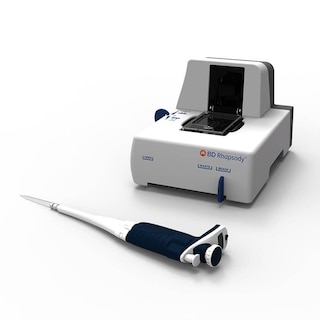-
Your selected country is
Middle East / Africa
- Change country/language
Old Browser
This page has been recently translated and is available in French now.
Looks like you're visiting us from {countryName}.
Would you like to stay on the current country site or be switched to your country?


Oligo Mouse Anti-Human CXCR6 (CD186)
Regulatory Status Legend
Any use of products other than the permitted use without the express written authorization of Becton, Dickinson and Company is strictly prohibited.
Preparation And Storage
Recommended Assay Procedures
Put all BD® AbSeq Reagents to be pooled into a Latch Rack for 500 µL Tubes (Thermo Fisher Scientific Cat. No. 4900). Arrange the tubes so that they can be easily uncapped and re-capped with an 8-Channel Screw Cap Tube Capper (Thermo Fisher Scientific Cat. No. 4105MAT) and the reagents aliquoted with a multi-channel pipette.
BD® AbSeq tubes should be centrifuged for ≥ 30 seconds at 400 × g to ensure removal of any content in the cap/tube threads prior to the first opening.
Product Notices
- This reagent has been pre-diluted for use at the recommended volume per test. Typical use is 2 µl for 1 × 10^6 cells in a 200-µl staining reaction.
- Source of all serum proteins is from USDA inspected abattoirs located in the United States.
- Caution: Sodium azide yields highly toxic hydrazoic acid under acidic conditions. Dilute azide compounds in running water before discarding to avoid accumulation of potentially explosive deposits in plumbing.
- The production process underwent stringent testing and validation to assure that it generates a high-quality conjugate with consistent performance and specific binding activity. However, verification testing has not been performed on all conjugate lots.
- Illumina is a trademark of Illumina, Inc.
- Please refer to http://regdocs.bd.com to access safety data sheets (SDS).
- Please refer to bd.com/genomics-resources for technical protocols.
- For U.S. patents that may apply, see bd.com/patents.
Companion Products






The 13B 1E5 monoclonal antibody specifically binds to C-X-C chemokine receptor type 6 (CXCR6), which is also known as CD186, BONZO, T-lymphocyte-expressed seven-transmembrane domain receptor (TYMSTR), and Seven transmembrane receptor-like from clone 33 (STRL33). CXCR6 is a G-protein coupled chemokine receptor that is expressed on subsets of activated and memory T cells and NKT cells. CXCR6 binds to soluble CXCL16 and membrane-anchored CXCL16 expressed by dendritic cells and macrophages. The CXCL16 and CXCR6 interaction activates Akt and mTor signaling. This regulates cellular migration including the recruitment of tumor-infiltrating lymphocytes and may contribute to the progression and metastasis of various cancers. CXCR6 also can serve as a coreceptor for certain strains of HIV-1 and HIV-2.
Development References (6)
-
Deng HK, Unutmaz D, KewalRamani VN, Littman DR. Expression cloning of new receptors used by simian and human immunodeficiency viruses.. Nature. 1997; 388(6639):296-300. (Biology). View Reference
-
La Porta CA. CXCR6: the role of environment in tumor progression. Challenges for therapy.. Stem Cell Rev. 2012; 8(4):1282-5. (Biology). View Reference
-
Liao F, Alkhatib G, Peden KW, Sharma G, Berger EA, Farber JM. STRL33, A novel chemokine receptor-like protein, functions as a fusion cofactor for both macrophage-tropic and T cell line-tropic HIV-1.. J Exp Med. 1997; 185(11):2015-23. (Biology). View Reference
-
Loetscher M, Amara A, Oberlin E, et al. TYMSTR, a putative chemokine receptor selectively expressed in activated T cells, exhibits HIV-1 coreceptor function.. Curr Biol. 1997; 7(9):652-60. (Biology). View Reference
-
Murphy PM. International Union of Pharmacology. XXX. Update on chemokine receptor nomenclature.. Pharmacol Rev. 2002; 54(2):227-9. (Biology). View Reference
-
Xiao G, Wang X, Wang J, et al. CXCL16/CXCR6 chemokine signaling mediates breast cancer progression by pERK1/2-dependent mechanisms.. Oncotarget. 2015; 6(16):14165-78. (Biology). View Reference
Please refer to Support Documents for Quality Certificates
Global - Refer to manufacturer's instructions for use and related User Manuals and Technical data sheets before using this products as described
Comparisons, where applicable, are made against older BD Technology, manual methods or are general performance claims. Comparisons are not made against non-BD technologies, unless otherwise noted.
For Research Use Only. Not for use in diagnostic or therapeutic procedures.
Report a Site Issue
This form is intended to help us improve our website experience. For other support, please visit our Contact Us page.